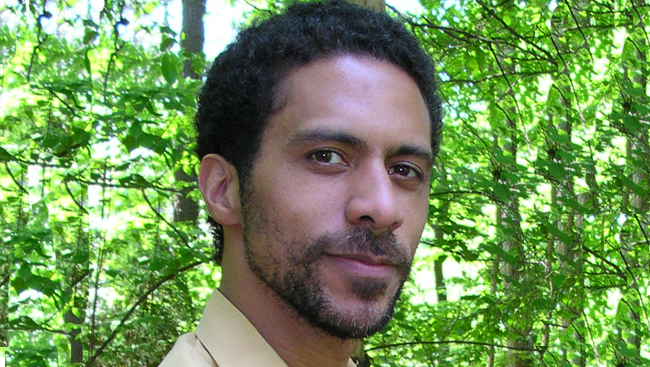Erich Jarvis: Connecting Birdsong to Human Speech
- Published10 Apr 2013
- Reviewed10 Apr 2013
- Author Mary Bates
- Source BrainFacts/SfN
Erich Jarvis made a name for himself in science by asking big questions and refusing to back down when these questions meant he would have to look outside of his area of expertise to find the answers. For the past 20 years, Jarvis, associate professor of neurobiology at Duke University Medical Center and a Howard Hughes Medical Institute Investigator, has studied the ability of animals to imitate sounds (a process known as vocal learning).

Erich Jarvis is an associate professor of neurobiology at Duke University Medical Center.
Jarvis' research aims to reveal how the brain learns and generates vocalizations, such as speech. Such studies may one day shed light on the evolution and mechanisms of spoken language in humans, and the causes of speech disorders.
Jarvis is the recipient of numerous awards for his research, including the Alan T. Waterman Award, the National Science Foundation's highest honor for a young researcher, and the National Institutes of Health Director's Pioneer Award. For nearly four years Jarvis has served as the program director of the Society for Neuroscience's Neuroscience Scholars Program, a three-year fellowship that provides career development and professional opportunities for underrepresented and diverse undergraduate students, graduate students, and postdoctoral fellows in neuroscience. Over the course of his career, Jarvis has mentored hundreds of young neuroscientists.
What do you study in your lab?
I study vocal learning (sound imitation) in animals, particularly song learning birds. You can think of vocal learning as the foundation of human language. While there are some big differences between human language and birdsong, there is also a great deal of similarity in the pathways the brain uses to learn and produce vocal sounds.
By studying vocal learning birds, including those that can imitate human speech, such as parrots, we can find the essential brain pathways, genes, and behaviors that are necessary for this trait.
How common is vocal learning?
It's actually a pretty rare trait. The sounds most animals make are innate, which means they are limited in their ability to alter them or mimic other sounds.
Six months ago I would have told you that the only vocal learners were songbirds, parrots, and hummingbirds amongst birds, and dolphins, bats, elephants, sea lions, and humans amongst mammals. But recent research, including studies in our lab, suggests different species, including mice, may have the ability to imitate sound to different degrees.
How are the brains of vocal learners different from other animals?
Vocal learners all have a connection, or pathway, between neurons in the forebrain — a brain region that helps control vocal learning — and neurons in the brainstem, which control the muscles involved in producing innate vocalizations. When we look at these pathways across vocal learners, we see that they're very similar, even though these species are only distantly related to one another.
How did learning evolve in such distantly related species?
In the songbird, the evidence suggests that the brain centers involved in vocal learning evolved from a motor control pathway. What separates vocal learners and non-learners could have been a genetic mutation that occurred in the learners that controls the connection of the forebrain vocal learning pathways to the brainstem motor neurons that control vocal production. This would explain how vocal learning could arise in distantly related animals.
What methods do you use to answer these questions?
Answering questions about the mechanisms of spoken language or how vocal learning evolved requires attacking the question from multiple angles, including using the tools and techniques in the fields of genetics, cell biology, and anatomy.
If I have a question, I'm going to find whatever means I can to answer it. Getting the big science done requires collaboration.
In addition to your research, you are known for your active role in the Neuroscience Scholars Program (NSP), which aims to increase the likelihood that diverse trainees who enter the neuroscience field continue to advance in their careers. What sorts of challenges do minorities in the sciences face?
I think there are several main types of challenges that minorities face, which I learned from my own personal experience as an African American and part Native American. One challenge is more internal — you have to have strong enough self-esteem to believe you are where you are because of your abilities and qualifications alone, as well as the confidence to go after what you want. The other type of challenge is external, as minorities often face the unconscious biases from others, including faculty and mentors.
What can be done to overcome these challenges?
We've got to get rid of both the internal and external biases. To do this requires a lot more mentoring, a lot more sensitivity training of faculty and others who are doing the mentoring of young minorities in the sciences, and a village of support. Once you have these things in place, I think we'll have a much greater impact.
It's been shown time and again if you have a culturally diverse workforce, everyone benefits. Everyone will make more advancements and be more successful. I've seen that in my own lab, which tends to be diverse not only in the techniques that we use but in the people that come to it.
CONTENT PROVIDED BY
BrainFacts/SfN
Also In Archives
Trending
Popular articles on BrainFacts.org


















